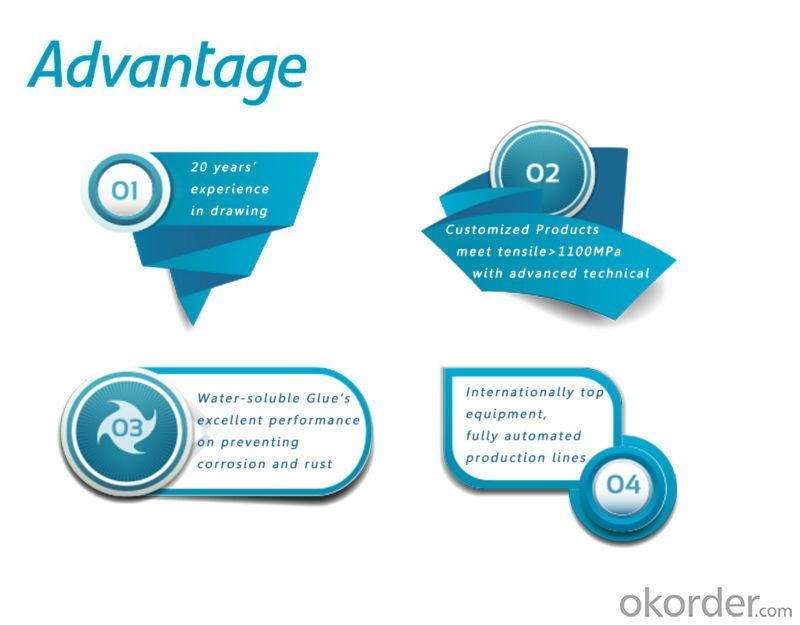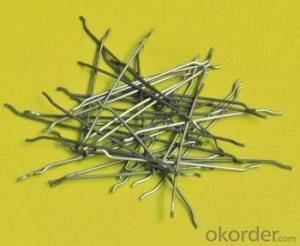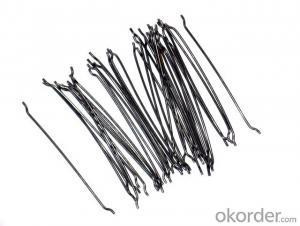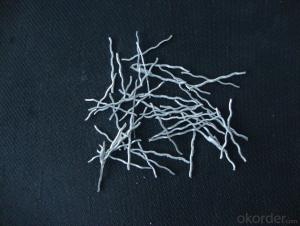Melt Extract Stainless Steel Fiber for Construction Companies UAE High Quality
- Loading Port:
- Tianjin
- Payment Terms:
- TT OR LC
- Min Order Qty:
- 1 m.t.
- Supply Capability:
- 600 m.t./month
OKorder Service Pledge
Quality Product, Order Online Tracking, Timely Delivery
OKorder Financial Service
Credit Rating, Credit Services, Credit Purchasing
You Might Also Like
Quick Details
Place of Origin: Tianjin, China (Mainland)
Model Number: 0.55
Material: Steel
Production Process: Cold drawn
Fiber Lengh: 35
Type: 1
Compressive Strength: >1200MPa
Aspect ratio: 63
Standard: ASTM A820M-11
Section Shape: Circular
Application: Concrete Reinforcement
Product Application: Industrial Floor
Packaging & Delivery
| Packaging Details: | 20 kg/Bag,50 bags/Pallet or 1,000kg/ Bulk Bag |
|---|---|
| Delivery Detail: | 1 Month |
Product Description
| Diameter | 0.55 mm (0.217 in) | ||
| Length | 35 mm (13.780 in) | ||
| Aspect Ratio | 63 | ||
| Tensile strength | 1200 MPa | ||
| Type | Cold drawn Steel Fiber | ||
| End | Hooked-end Steel Fiber | ||
| Glued/Loose | Glued Steel Fiber | ||
| Bending Angle | 45°(min.30°) | ||
| Usage & Performance | Floor:Trafficked areas and Industrial floors | ||
| Shotcrete :Slope stabilization and Final lining | |||
| Precast concrete:Pipe and Railway sleepers | |||
| Packing | Standard Export Pallet Packing | Bag Packing | 20 kg/Bag,50 bags/Pallet |
| Bulk Packing | 1,000kg/ Bulk Bag | ||
| Loading Quantity | 20’GP | 20-25 Tonne/Tonnes | |
| 40’GP | 25-27 Tonne/Tonnes | ||
| 40’HQ | 25-27 Tonne/Tonnes | ||
| MOQ | 1 kg for trial order | ||
| Supply Ability | 10,000 Tonne/Tonnes per Year | ||
| Payment Terms | T/T or L/C at sight | ||
| Delivery Time | Within 15 days after receiving deposit or original L/C at sight | ||
| Certification | ISO9001:2000, CE, | ||

| Product | Diameter | Length mm/in | Aspect Ratio | Type | Packing |
| G-6030 | 0.5 mm (0.197 in) | 30 mm (11.811 in) | 60 | Glued | 20 kg/Bag, or 1,000kg/ Bulk Bag |
| G-6535 | 0.55 mm (0.217 in) | 35 mm (13.780 in) | 65 | Glued | 20 kg/Bag, or 1,000kg/ Bulk Bag |
| G-6035 | 0.6 mm (0.236 in) | 35 mm (13.780 in) | 60 | Glued | 20 kg/Bag, or 1,000kg/ Bulk Bag |
| G-8060 | 0.75 mm (0.295 in) | 60 mm (23.622 in) | 80 | Glued | 20 kg/Bag, 50 bags/Pallet |
| G-6060 | 0.9 mm (0.354 in) | 60 mm (23.622 in) | 60 | Glued | 20 kg/Bag, 50 bags/Pallet |
| G-6030 | 0.5 mm (0.197 in) | 30 mm (11.811 in) | 60 | Loose | 20 kg/Bag, or 1,000kg/ Bulk Bag |
| G-6535 | 0.55 mm (0.217 in) | 35 mm (13.780 in) | 65 | Loose | 20 kg/Bag, or 1,000kg/ Bulk Bag |
| G-6035 | 0.6 mm (0.236 in) | 35 mm (13.780 in) | 60 | Loose | 20 kg/Bag, or 1,000kg/ Bulk Bag |
| G-8060 | 0.75 mm (0.295 in) | 60 mm (23.622 in) | 80 | Loose | 20 kg/Bag, 50 bags/Pallet |
| G-6060 | 0.9 mm (0.354 in) | 60 mm (23.622 in) | 60 | Loose | 20 kg/Bag, 50 bags/Pallet |
- Q: Does melt extract stainless steel fiber improve the resistance to freeze-thaw cycles of concrete?
- Yes, melt extract stainless steel fiber can improve the resistance to freeze-thaw cycles of concrete. These fibers help to enhance the overall durability and performance of concrete by reducing cracking, improving tensile strength, and minimizing the effects of freeze-thaw damage. The stainless steel fibers disperse throughout the concrete matrix, reinforcing it and providing a barrier against water absorption. This ultimately helps to prevent the expansion and contraction of concrete during freeze-thaw cycles, leading to improved resistance and longevity.
- Q: What is the effect of melt extract stainless steel fiber on the dimensional stability of concrete?
- The use of melt extract stainless steel fiber in concrete has a significant effect on the dimensional stability of the material. These fibers are added to the concrete mixture during the mixing process, where they are evenly dispersed throughout the mixture. One of the main benefits of melt extract stainless steel fiber is its ability to enhance the overall strength and durability of concrete. The fibers act as reinforcement, providing additional tensile strength to the material. This reinforcement helps to prevent cracking and shrinkage, which are common issues in concrete structures. By reducing cracking and shrinkage, melt extract stainless steel fiber improves the dimensional stability of concrete. This means that the concrete maintains its original shape and size over time, even under varying environmental conditions such as temperature changes or moisture exposure. The addition of these fibers also improves the overall performance of the concrete in terms of resistance to impact, abrasion, and fatigue. This makes it particularly useful in applications where the concrete will be subjected to heavy loads or frequent wear and tear. Furthermore, melt extract stainless steel fiber can also enhance the fire resistance of concrete. The fibers have a high melting point, which helps to slow down the spread of fire and prevent structural collapse. This is especially important in buildings and structures where fire safety is a concern. Overall, the use of melt extract stainless steel fiber in concrete greatly improves its dimensional stability, strength, and durability. This leads to longer-lasting, more reliable concrete structures that are better able to withstand various environmental and mechanical forces.
- Q: Can melt extract stainless steel fiber be used in decorative precast concrete applications?
- Yes, melt extract stainless steel fiber can be used in decorative precast concrete applications.
- Q: What is the effect of melt extract stainless steel fiber on the fatigue life of asphalt mixtures?
- The use of melt extract stainless steel fiber in asphalt mixtures has a positive effect on the fatigue life. The presence of these fibers improves the overall strength and durability of the asphalt mixture, reducing the occurrence of cracks and fatigue failure. The fibers act as reinforcement, enhancing the asphalt's resistance to repetitive loading and increasing its fatigue life.
- Q: Can melt extract stainless steel fiber replace traditional reinforcement methods in concrete?
- Melt extract stainless steel fiber has the potential to replace traditional reinforcement methods in concrete. These fibers, made from high-quality stainless steel, offer excellent resistance to corrosion and high tensile strength. By improving the mechanical properties of concrete, enhancing durability, and increasing resistance to cracking and impact, these fibers provide numerous advantages compared to traditional methods. One advantage of stainless steel fibers is their ease of handling and installation. They can be easily added to the concrete mix during batching, eliminating the need for labor-intensive installation of steel bars or wire mesh. This saves time and effort. Furthermore, stainless steel fibers eliminate the risk of corrosion, a common problem with traditional reinforcement methods. Corrosion can significantly reduce the lifespan and strength of concrete structures. In contrast, stainless steel fibers are highly resistant to corrosion, ensuring the longevity and durability of the concrete. Additionally, melt extract stainless steel fibers improve the overall performance of concrete. They enhance flexural and tensile strength, making the material more resistant to cracking and deformation. This is particularly useful in applications where concrete is subjected to heavy loads or dynamic forces, such as industrial flooring, bridge decks, or airport runways. In conclusion, melt extract stainless steel fiber presents a viable alternative to traditional reinforcement methods in concrete. Its corrosion resistance, high tensile strength, and ease of installation make it an attractive option for improving the performance and durability of concrete structures. However, careful consideration of the specific application and design requirements is necessary before deciding on the suitability of using stainless steel fibers as a replacement for traditional reinforcement methods.
- Q: Can melt extract stainless steel fiber be used in bridge decks or infrastructure projects?
- Yes, melt extract stainless steel fiber can be used in bridge decks or infrastructure projects. These fibers enhance the durability and structural strength of concrete, making it more resistant to cracking and improving its overall performance under heavy loads and harsh environmental conditions.
- Q: How does melt extract stainless steel fiber improve the resistance to fatigue in concrete?
- Melt extract stainless steel fiber improves the resistance to fatigue in concrete by enhancing the overall strength and durability of the material. The addition of stainless steel fibers helps to distribute and dissipate stress more effectively, reducing the formation and propagation of cracks. This reinforcement also increases the flexural strength and toughness of the concrete, making it more resistant to cyclic loading and potential fatigue failure.
- Q: How does melt extract stainless steel fiber affect the impact resistance of shotcrete?
- Shotcrete's impact resistance is greatly enhanced by melt extract stainless steel fiber. Shotcrete, which is typically used in construction and repair projects, is a high-strength concrete material that is sprayed onto surfaces. The inclusion of stainless steel fibers in shotcrete increases its tensile strength and toughness, rendering it highly resistant to impact and dynamic loads. Manufactured through a specialized process involving the melting of raw materials and their rapid extraction into thin, elongated fibers, melt extract stainless steel fibers are then incorporated into the shotcrete mix, ensuring even dispersion throughout the material. These fibers create a three-dimensional reinforcement network within the shotcrete, providing enhanced resistance to cracking and fragmentation when subjected to impact. The stainless steel fibers in shotcrete act as micro-reinforcements when confronted with impact forces, effectively absorbing and distributing the energy throughout the material. This prevents the formation and propagation of cracks, leading to improved impact resistance. The fibers also increase the shotcrete's ductility, allowing it to absorb more energy before failure. Furthermore, the corrosion resistance of stainless steel fibers ensures the long-term durability and performance of the shotcrete. These fibers do not rust or deteriorate over time, even in harsh environmental conditions, further enhancing the overall impact resistance of shotcrete. In conclusion, the addition of melt extract stainless steel fiber significantly enhances shotcrete's impact resistance. The fibers reinforce the material, prevent crack formation, and improve its toughness and ductility. Consequently, shotcrete with stainless steel fibers is an excellent choice for applications where impact resistance is of paramount importance, such as tunnel linings, retaining walls, and protective barriers.
- Q: What is the effect of melt extract stainless steel fiber on the drying shrinkage of concrete?
- The effect of melt extract stainless steel fiber on the drying shrinkage of concrete is typically positive. The addition of these fibers helps to reduce the overall drying shrinkage and cracking potential of the concrete. When concrete undergoes the drying process, it tends to shrink as the water evaporates from the mixture. This shrinkage can lead to the development of cracks, which can compromise the integrity and durability of the structure. However, by incorporating melt extract stainless steel fibers into the concrete mix, the overall shrinkage of the material can be significantly reduced. These fibers act as reinforcement within the concrete, helping to distribute the stresses and strains more evenly. This reduces the likelihood of cracking during the drying process. Melt extract stainless steel fibers have a high tensile strength and excellent corrosion resistance, making them an ideal choice for this application. They also provide enhanced durability and increased resistance to cracking caused by shrinkage and temperature changes. In summary, the addition of melt extract stainless steel fibers to concrete can effectively mitigate drying shrinkage and reduce the potential for cracking. This results in a more durable and long-lasting concrete structure.
- Q: How does melt extract stainless steel fiber affect the shear strength of concrete?
- Melt extract stainless steel fiber has a significant impact on the shear strength of concrete. When added to the concrete mixture, these fibers enhance its overall structural integrity and resistance to shear forces. The fibers act as reinforcement by bridging cracks and distributing stress throughout the concrete matrix. The addition of melt extract stainless steel fibers increases the interlocking effect between the fibers and the surrounding concrete matrix, resulting in improved shear strength. These fibers effectively resist the forces that cause concrete to crack and fail under shear loads. They prevent the propagation of cracks by transferring shear stresses across the crack faces, thus increasing the shear resistance of the concrete. Furthermore, the high tensile strength and ductility of stainless steel fibers make them highly effective in enhancing the shear capacity of concrete. The fibers absorb energy during loading and dissipate it through deformation, which helps to delay and control the development of cracks. This ultimately improves the shear resistance and overall durability of the concrete structure. It is important to note that the effectiveness of melt extract stainless steel fibers in enhancing shear strength depends on various factors such as fiber content, aspect ratio, and distribution within the concrete mixture. The optimal dosage and distribution of fibers should be carefully considered to achieve the desired improvement in shear strength. Additionally, proper concrete mix design and fiber dispersion techniques are crucial to ensure the successful integration and performance of the stainless steel fibers. In summary, the addition of melt extract stainless steel fibers significantly improves the shear strength of concrete by enhancing its crack resistance, transferring shear stresses, and absorbing energy. These fibers play a crucial role in reinforcing the concrete matrix and increasing its overall structural integrity, making it more resistant to shear forces and improving the durability of the concrete structure.
Send your message to us
Melt Extract Stainless Steel Fiber for Construction Companies UAE High Quality
- Loading Port:
- Tianjin
- Payment Terms:
- TT OR LC
- Min Order Qty:
- 1 m.t.
- Supply Capability:
- 600 m.t./month
OKorder Service Pledge
Quality Product, Order Online Tracking, Timely Delivery
OKorder Financial Service
Credit Rating, Credit Services, Credit Purchasing
Similar products
Hot products
Hot Searches
Related keywords

























